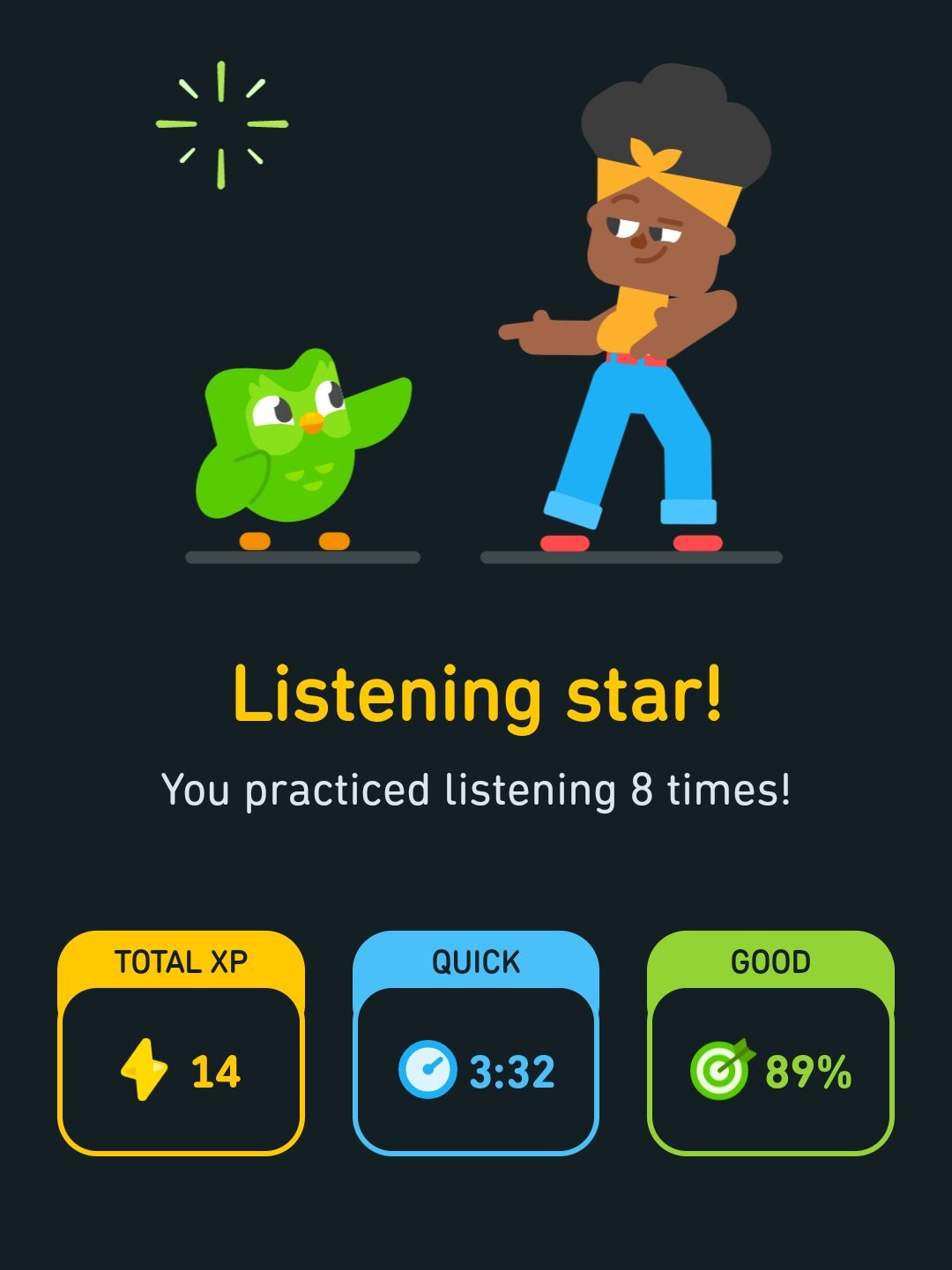Understanding what creates and upholds habits is a powerful thing. One of the best examples of a website that uses habit-forming tech for a positive goal is Duolingo which has fast become a leading language learning app. Below, read some of the elements of their success.
The Impact of a Habitual Action
Habits – A Powerful Force for Change
Let’s say you see someone behind you in line at the grocery store and they have a fussy baby. Perhaps you smile at them and maybe even let them in front of you in line. Maybe you even try to distract the baby with funny faces so the parent can concentrate. It might make a difference. It might not. It is possible the parent won’t want help but, according to research, strangers often do enjoy connection. So the likelihood is that your attempt to help make the child smile will make the parent’s day a little easier and happier. Perhaps they even see the world as a kinder place.
Now imagine that you perform a kind action like this each day for 5 years. That habit has positively impacted many times more people than that single act. Moreso if a few of the people who experienced your kindness were inspired to copy you.
Keeping up a new habit? That part is hard!
Anyone who has attempted to create a new habit – say, to start exercising daily – has learned that upholding a new habit over the long term is hard! Distractions, lack of positive reinforcement, and forgetfulness can make it easy to fall out of habit.
Automated Habit-forming Design Can Help
That’s where the habit-forming capabilities of phones and websites can be so powerful to create change.

Duolingo’s Habit-forming Design Assets
Duolingo is a language-learning app founded in 2009 by Carnegie Mellon University professor Luis von Ahn and his student Severin Hacker. The belief behind its creation was that “free education will really change the world.” The company uses a freemium model, with an optional ad-free premium service that offers additional features. The app stands out in its ability to help users form habits and inspire them to get friends to join. As of February 2023, Duolingo was the world’s most popular language learning app with almost 13.4 million users downloading it that month.
What builds habits?
Some of the strongest ways to build habits include: Reminders, Bite-sized Activities, Randomized Rewards, and ample Positive Reinforcement.
Below learn more about Duolingo’s strongest habit-forming assets.
Phone Notification Reminders
Mobile phone notifications can be a boon for you or a frustration for your users.
Why Choice Helps You
Duolingo’s notifications make it easy for the user to increase, decrease, and stop notifications. It is key that they offer the choice up front. You may get your user’s attention more regularly if you force notifications on them, but you may also end up with annoyed customers who leave!
Give Users a Reason To Opt In

Many of Duolingo’s users actually want to remember to keep coming back. Helping users be reminded only as much as they want to be reminded makes the notifications more welcome and, thus, more effective!
Bite-sized Activities Get Users In The Door
Small is powerful in this case. Time investment minimums are small. To finish an activity only takes about 5 minutes. This can easily fit into a person’s schedule. Once the person starts playing, they’re given incentives to keep playing for 2x or more points after they complete a few activities. Users interviewed have commented that the incentives often come as they’re about to stop, suggesting that this aspect, too, was user-tested for optimal timing and effect.
Variation is Enticing
To avoid boredom, Duolingo provides many different ways to practice languages.
Streak Counts That Are Rewarded
Streak counts are popping up in more and more gamified digital experiences. Badges are commonly the reward. The badges are varied in a way that illicits the randomized “slot machine” effect which makes the experience more habit-forming. Duolingo adds the varied social component to this by making it seamless to post badge achievements. This adds the reward of enjoying their friends cheering for their new badges.

Social Experiences with Real People to Keep It Interesting – and Increase Marketing Outreach
The variation of a slot machine is what draws your brain back. Few things are more varied than interactions with other living beings. Rewards in the form of real human interactions not only keep it interesting, the intrinsic variation of them builds the craving to play. The social component is further encouraged by Duolingo’s use of “Quests” where two users work together toward a common goal. All of these social components give the user incentive to get their friends to play too, meaning the user is now doing the marketing for you!
Social Experiences with Imaginary Characters Help Too
As we’ve mentioned, one of the strongest habit-builders is the social component. This appears to also work, to a lesser extent, with imaginary characters. The collection of Duolingo characters dance and engage in amusing, surprising activities, making the game feel friendly. The inclusion of a single hard-to-please character introduces a small nudge of negative reinforcement, which makes the positive reinforcement feel stronger by comparison.

Phone Widgets with Reactive Characters
The Duolingo bird character, Duo, is the only character you see on the phone widget. It engages in randomness, humor, and both positive and negative reinforcement to encourage habitual practice. The Duo character captures the user’s attention through a variety of dramatic poses and scenes throughout the day. The scenes are exciting and epic earlier in the day and grow more amusingly upset as the day (and time left to uphold one’s streak) winds to an end. This tempts the person to get in their practice early before Duo starts getting upset! Duolingo affectively threads the needle of keeping the interaction only mildly negative due to the melodramatic humor in harnesses. This is especially true when the widget becomes a ridiculous and hilarious paniced inferno the last hour before midnight.
A Variety of Game Play Options
Duolingo could get boring pretty quickly if it was the same game format over and over. The variety of formats keep it interesting in part because they allow the user to choose. They can also pick between Stories, Speaking Practice, Listening Practice, Mistakes Review, and a speed-focused Words option. Or, by default, the user can stick with the provided path which includes a mix of all of these activities.
Abundant Positive Reinforcement

My experiences in Management and Education have made evident the power of positive reinforcement over negative. Negative reinforcement does drive action but can leave a negative taste and lead to burnout if done too heavily. Duolingo characters dance and cheer for your completed lesson whether it’s perfect or flawed. When the user makes mistakes in a lesson, Duolingo keeps negative reactions brief and minimal. Then, at the end of the lesson, they call out what you did well, focusing more on fixed mistakes than failure. This comes together to help the whole experience feel positive when the user walks away – which is key to making them want to come back.
Who They Serve Counts
My research into Duolingo, including interviews with the founder, has brought me to conclude that this business uses habit-forming technology to serve their user and as opposed to using it against them.
There is good reason not to use these techniques against the user. For instance, a retail application might warn that something is about to sell out even though they have ample supply. The Scarcity Principal may encourage users to buy, but they are also likely to catch on that you’re trying to trick them and lose trust.
I’d like to posit that it should be the imperative of all businesses to follow the B-Corp model and put people and planet as highest-level priorities alongside profit. Knowledge of habit-forming technology can be used to help the user, improve efficiency, make a better product, and hopefully make a positive impact on the world. It also helps your users and employees trust you and become more passionate supporters.
How Habit-forming Interactions Activate Your Goals
Interactions like those listed above keep your users coming back. They also encourage your users to get their friends to join – a powerful way to spread your reach and further strengthen habits. Habit-forming does the selling for you!
We love creating successful, habit-forming interactive digital experience for your users! Reach out to us for a quote to get started.




